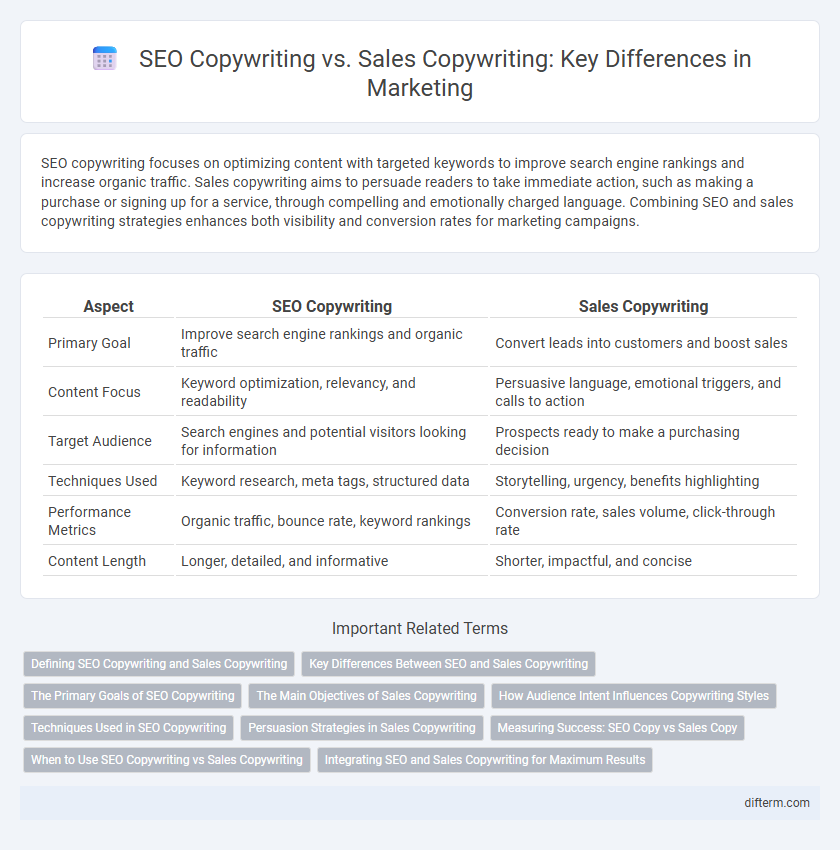SEO copywriting focuses on optimizing content with targeted keywords to improve search engine rankings and increase organic traffic. Sales copywriting aims to persuade readers to take immediate action, such as making a purchase or signing up for a service, through compelling and emotionally charged language. Combining SEO and sales copywriting strategies enhances both visibility and conversion rates for marketing campaigns.
Table of Comparison
| Aspect | SEO Copywriting | Sales Copywriting |
|---|---|---|
| Primary Goal | Improve search engine rankings and organic traffic | Convert leads into customers and boost sales |
| Content Focus | Keyword optimization, relevancy, and readability | Persuasive language, emotional triggers, and calls to action |
| Target Audience | Search engines and potential visitors looking for information | Prospects ready to make a purchasing decision |
| Techniques Used | Keyword research, meta tags, structured data | Storytelling, urgency, benefits highlighting |
| Performance Metrics | Organic traffic, bounce rate, keyword rankings | Conversion rate, sales volume, click-through rate |
| Content Length | Longer, detailed, and informative | Shorter, impactful, and concise |
Defining SEO Copywriting and Sales Copywriting
SEO copywriting involves crafting content optimized with relevant keywords and search phrases to improve website visibility and rankings on search engines. Sales copywriting focuses on persuasive language designed to engage potential customers, highlight benefits, and drive conversions or direct sales. Both approaches require tailored messaging, but SEO copy prioritizes organic traffic generation while sales copy targets immediate action and customer acquisition.
Key Differences Between SEO and Sales Copywriting
SEO copywriting focuses on keyword optimization, search engine rankings, and increasing organic traffic by integrating relevant phrases naturally within informative content. Sales copywriting prioritizes persuasive language, emotional appeals, and clear calls-to-action designed to convert readers into customers. The key difference lies in SEO copywriting targeting search engines to boost visibility, while sales copywriting targets human emotions to drive immediate sales.
The Primary Goals of SEO Copywriting
SEO copywriting primarily aims to improve website visibility on search engines by incorporating relevant keywords, optimizing meta tags, and creating content that aligns with search intent. Its goal is to attract organic traffic by addressing user queries and providing valuable information that ranks well in SERPs. Unlike sales copywriting, SEO copywriting focuses on long-term audience engagement and enhancing site authority rather than immediate conversions.
The Main Objectives of Sales Copywriting
Sales copywriting aims to convert prospects into customers by crafting persuasive messages that highlight product benefits and evoke strong emotional responses. Its main objective is to drive immediate action, such as making a purchase or signing up for a service, by creating urgency and trust. Unlike SEO copywriting, which focuses on improving search engine rankings, sales copywriting centers on boosting conversion rates and revenue generation.
How Audience Intent Influences Copywriting Styles
Audience intent shapes SEO copywriting by emphasizing keyword integration and content relevance to improve search engine rankings and attract organic traffic. Sales copywriting prioritizes persuasive language and emotional triggers to convert visitors into customers by addressing immediate desires and pain points. Understanding whether the audience seeks information or is ready to purchase determines the balance between informative content and compelling calls-to-action.
Techniques Used in SEO Copywriting
SEO copywriting techniques emphasize keyword research, strategic keyword placement, and crafting compelling meta titles and descriptions to improve search engine rankings. Content optimization involves using headers, bullet points, and internal linking to enhance readability and user experience. Incorporating relevant keywords naturally and maintaining high-quality, informative content are essential for driving organic traffic and increasing website visibility.
Persuasion Strategies in Sales Copywriting
Sales copywriting employs advanced persuasion strategies such as emotional appeals, urgency triggers, and clear calls-to-action to drive conversions and maximize ROI. Unlike SEO copywriting, which targets search engine algorithms through keyword optimization and content relevance, sales copywriting prioritizes audience engagement and buying motivation. Techniques like social proof, scarcity, and benefit-driven language are essential tools to influence consumer behavior in sales copywriting.
Measuring Success: SEO Copy vs Sales Copy
Measuring success in SEO copywriting hinges on metrics like organic traffic, keyword rankings, and click-through rates that indicate improved visibility and search engine performance. Sales copywriting success is evaluated through conversion rates, lead generation, and revenue growth, emphasizing direct customer engagement and persuasive messaging effectiveness. Both copy types require tailored analytics to optimize marketing strategies and achieve business objectives efficiently.
When to Use SEO Copywriting vs Sales Copywriting
SEO copywriting should be used when the goal is to increase organic traffic by optimizing content with relevant keywords, meta tags, and search engine-friendly structures to improve search rankings. Sales copywriting is most effective when the aim is to persuade visitors to take immediate action, such as making a purchase or signing up for a service, by crafting compelling, benefit-driven messages that resonate with the target audience. Marketers often use SEO copywriting in blog posts and informational pages, while sales copywriting is preferred for landing pages, product descriptions, and email campaigns.
Integrating SEO and Sales Copywriting for Maximum Results
Integrating SEO and sales copywriting maximizes online visibility and conversion rates by combining keyword-rich content with persuasive messaging tailored to the target audience. Effective SEO copywriting enhances search engine rankings through optimized headlines, meta descriptions, and strategic keyword placement, while sales copywriting drives engagement and motivates action via compelling calls-to-action and benefit-oriented language. A seamless blend of these approaches ensures content not only attracts organic traffic but also converts visitors into loyal customers, boosting both traffic quality and revenue.
SEO copywriting vs sales copywriting Infographic

 difterm.com
difterm.com